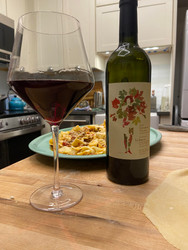Giovanna Morganti Delivers
Posted by Connor Kennedy on March 01 2023 8:34pm
The very name “Tuscany” evokes dreams of wine; images of rolling vineyards fill the mind whenever it's uttered, along with spurring a sudden yearning to be in the Italian countryside and drinking wine right from the source. As cliché as this is, there are reasons the name has such power. Tuscany has earned international prestige for its genre-defining wines, such as Brunello di Montalcino, Chianti Classico, and the indomitable “Super-Tuscans”. But this prestige has come at a cost for some, bringing an emphasis on producing specific styles of wine, with specific grapes for an enormous international demand. Large-scale, corporate operations set the tone, and smaller producers had little choice but to follow suit. But the tides are shifting, as a new generation of Tuscan winemakers are fostering more intimate connections with the land and providing greater attention to the hundreds of indigenous grape varietals in Tuscany. Giovanna Morganti is one such winemaker, and her Podere Le Boncie has done serious work in restoring the region to its roots. I drank her “Chiesamonti’ this week, a Sangiovese-driven blend with a higher-toned character.
Podere Le Boncie sits quietly outside of Castelnuovo Berardenga, a small town in the Chianti-Classico producing zone in Tuscany. Giovanna Morganti, the head of the estate, received Le Boncie from her father, an esteemed oenologist from Tuscany who has always maintained a deep respect for the region’s long viticultural history, even before its explosion in worldwide popularity in the latter part of the 20th century. She studied oenology herself, and has worked for San Felice wines on a project to expand plantings over 300 old Tuscan grape varietals. Some of these grapes grow on her estate today, such as Colorino, Foglia Tonda, Mammolo, and Prugnolo. She, of course, grows much Sangiovese, the undisputed ruler of Tuscany. But these lesser-known grapes are often blended into the juice, providing an array of options to attain the pristine balance so characteristic of her wines.
The “Chiesamonti” comes from a single 1.3 hectare parcel called, well, Chiesa Monti, which translates to mountain church. The vineyard is almost entirely Sangiovese, with small amounts of Canaiolo comprising the plantings. Though the Caniolo juice makes up a small amount of the resulting wine, there’s no doubt Morganti was deliberate in how much of it she chose; it’s a grape known for softening Sangiovese’s harsher edges while lending its own fruity qualities to the wine. But there’s no doubt that Sangiovese leads the way here, as the wine exhibits its classic aromatics of cherry and forest floor, if with some delicate rose qualities on the periphery. The palate is soft, with a linear structure framed by a bright, lip-smacking acidity. There’s a gorgeous minerality to be found as well, giving some bounce to the tasty red fruit that came through more strongly with food.
Speaking of food, I shared the wine with some homemade duck ragu upon hand-rolled pappardelle noodles. I was torn while choosing Morganti’s wine, wondering if I should instead drink a wine from the Veneto where traditional duck ragu originates from. But the “Chiesamonti” has been something I’ve been keen to taste, and it was too hard to resist. That’s the beautiful thing about Italian wines - though regional cuisines are typically paired with their local wines, they’re all so eminently food-friendly it’s hard to screw it up. And Giovanna Morganti did us right.

